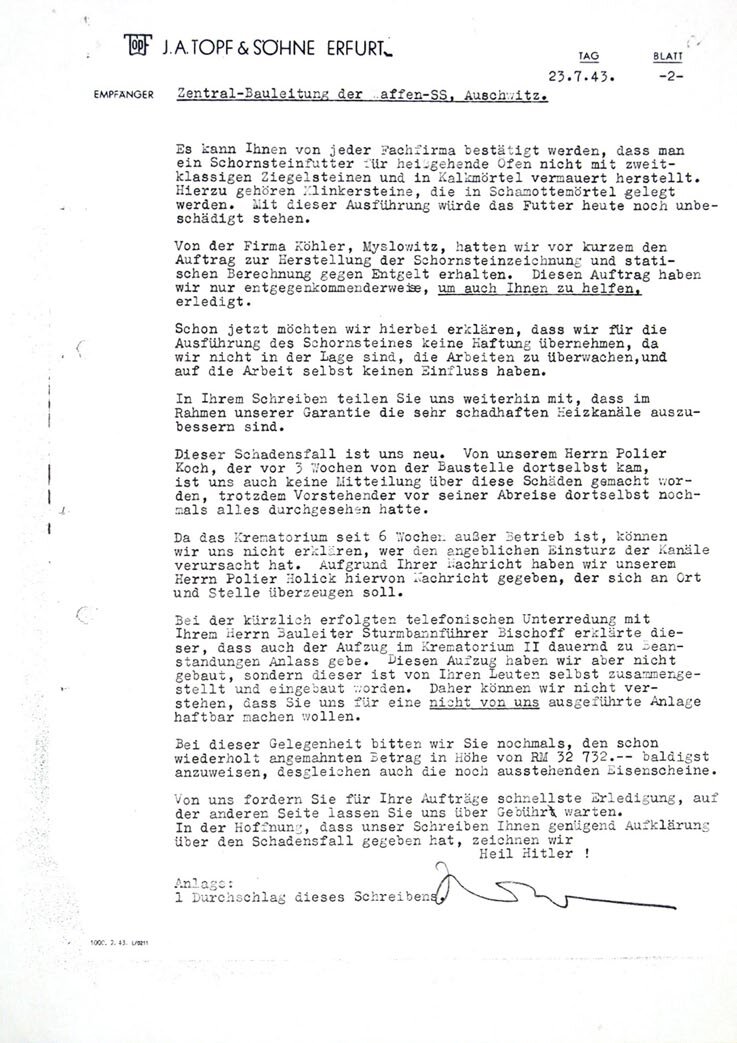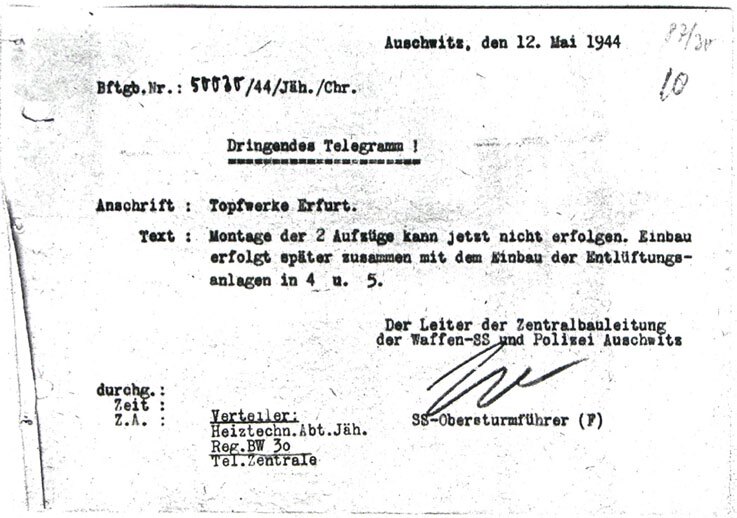The Freight Elevators of Crematoria II & III
An issue overlooked but clearly enlightening concerns the freight elevator used in Crematorium II. It is a classic example for a piece of evidence that blows all “criminal trace” out of the water at a single blast. Instead of summarizing the issue, I will use the text which Italian scholar Carlo Mattogno has compiled in this regard, slightly streamlined by me.147 It may be a little long, but it’s worthwhile reading, also because it clarifies what it means to put documents into their context.
Before turning to Mattogno’s text, however, a few introductory words are due.
The logistics of any major operation need to be well planned to make things run smoothly. If plans are made to mass murder people in a conveyor-belt fashion, having a conveyor-belt-like setup is very helpful. In our case, having a path of low resistance from the place of murder – the gas chamber – to the place of incineration – the cremation furnaces – would be good thinking. However, separating the two places by putting them on two different levels of the building, and then connecting these levels with merely a small freight elevator is the dumbest thing an engineer could ever come up with. Yet that was exactly the layout of Crematoria II & III. Let us therefore have a closer look into this marvel of German engineering as reported by Mattogno: the freight elevator of Crematorium II.
According to the initial plans, Crematoria II and III were to be equipped with freight elevators described as follows in the order given to Topf on February 28, 1943, by the Auschwitz Construction Office:148
“2 compl. electrical elevator machines incl. electric motors for three-phase 220/380 V, 7.5 HP each, special design, with overload protectors, limit switches, braking devices, platforms 2.10×1.35× 1.80 m with safety device, otherwise as per above mentioned cost estimate at 9,371 RM [Reichsmark] each = 18,742 RM.
1 patented Demag electric lift for 750 kg capacity, single cable, to be raised to 1500 kg capacity by addition of second cable, at 968 RM. This Demag electric lift must be supplied at once, as it will have to be used pending the arrival of the elevators mentioned in item 1.”Delivery for the first position was to be about seven months. Pressac shows drawing 5037 which was attached to the cost estimate by the Gustav Linse elevator company of Erfurt written on Jan. 25, 1943.149 This freight elevator was installed only in Crematorium III, between May 17 and June 6, 1943, by the Topf engineer Heinrich Messing (see the present book, page 371). In Crematorium II, a very crude makeshift elevator was installed which was ordered from the camp’s metalworking shop on Feb. 15, 1943. The order reads as follows:150
“February 15, 1943, PoW camp [=Birkenau] Crematorium I, BW 30. Object 1 flat-plate elevator for min. 300 kg payload incl. installation of respective reel device, cable and motor as well as guide rail. Order no. 2563/:146:/ of January 26, 1943 from Central Construction Office. Order taken over from former detainee metalworking shop, terminated March 13, 1943.”As can be seen from a Polish photograph of 1945 presented by Pressac, this elevator was very primitive (Photo 20, p. 488). It had to be repaired right away by Messing on April 12, 1943, who needed 11 hours for the job, but it still worked poorly.151
On July 23, 1943, Topf wrote a letter to the Auschwitz Construction Office stating (see Illustration 57):152
“In the recent telephone conversation with your site superintendent, Sturmbannführer Bischoff, the latter stated that the elevator in Crematorium II, as well, has been giving rise to permanent problems. We have, however, not built this elevator; rather, it was assembled and installed by your own people. We are, therefore, at a loss to see how you can make us responsible for a device not built by us.”Nonetheless, this poorly functioning elevator stayed in place until the end. The order for the two definitive freight elevators underwent a number of changes. On May 25, 1943, Topf thanked the Auschwitz Construction Office for having checked, approved and sent on to Berlin for payment four invoices. One of these was for the “Demag-Elektrozug,” another was “Crematorium II/III. Order no. 43/145/3. [for] 2 electrical elevators. RM 9,391.”153
A Topf listing, dated July 2, 1943, referring to the above order, shows a first partial payment of 9,371 RM, half the total amount (18,742 RM), but a handwritten entry by Jährling states that this installment had only amounted to 1,876.43 RM.154

Illustration 57: Topf letter addressing various complaints made by the Auschwitz Construction Office about malfunctioning or damaged equipment of Crematorium II, including its makeshift elevator made by the camp’s employees.

Illustration 58: The Auschwitz Construction Office postponed installing the elevators for Crematoria II & III in May 1944.
However, the freight elevators had not yet been supplied, and even ran the risk of never being actually delivered. On August 4, 1943, more than five months after the order for these devices, Topf informed the Construction Office that the manufacturing permit for them had not yet been granted:155
“We have learned today from our supplier that the Plenipotentiary for machine construction has not yet granted the construction permit. The application has been forwarded to the Reich minister for armaments and munitions [Albert Speer] requesting his decision.”Topf added that the plenipotentiary for machine construction had voted against the construction of the devices, and Topf therefore asked the Auschwitz Construction Office to get in touch with the Berlin authorities in order to have the request granted, speaking of serious consequences otherwise:
“For your information, please note that our supplier has already assembled the better part of the elevators. There is the danger, however, that the order has to be stopped immediately if the Reich minister for armaments and munitions does not give his approval.”This incident is in stark disagreement with the thesis that the Birkenau crematoria were the instruments for the implementation of Himmler’s extermination order: in such a case, any opposition on the part of the plenipotentiary for machine construction obviously would have been considered sabotage.
On September 9, 1943, the Auschwitz Construction Office sent to SS Hauptsturmführer Prinzl of Office C V of SS-WVHA a copy of the Topf letter of August 4, with the request to get in touch with the Reich minister for armaments and munitions in order “to obtain [the approval for] the realization of the elevators urgently required.”156 On May 12, 1944, the Auschwitz Construction Office sent Topf an “urgent telegram” regarding the elevators for Crematoria II & III stating (see Illustration 58):157
“installation of the 2 elevators cannot be done now. Installation will be done later, together with installation of air-extraction equipment in 4 and 5.”We can only speculate about the reason, but it may have to do with the fact that at that time the camp authorities were feverishly preparing to admit more than 400,000
Hungarian Jews to the camp, which must have resulted in an extreme shortage of available manpower.
If, however, the crematoria were meant to become the epicenter of the activities surrounding the deportation of the Hungarian Jews – meaning their gassing and cremation – the camp authorities would have expedited the installation of these devices!
It is not clear whether the two elevators were ever installed at all.
Therefore, the claimed extermination of some 500,000 people in Crematorium II would have been implemented using this primitive and poorly functioning device. As its capacity was 300 kg, or an average of five bodies of 60 kg each, the elevator would have had to do a total of 200,000 runs, 100,000 up and 100,000 down!
If we assume an average duration of five minutes for one complete operation (loading, upward journey, unloading, downward journey), then the transportation of 2,000 bodies from the basement to the furnace hall would have taken ([2,000÷5]×5 =) 2,000 minutes, or some 33 hours. Such an average duration, which corresponds to one minute for the transit time up and down and four minutes for the loading and unloading of the bodies (hence an average of 24 seconds for loading and another 24 seconds for unloading one corpse), is definitely too short for two reasons:
1. The elevator worked poorly, therefore one has to allow for lost time due to breakdowns, blockages, and delays.
2. According to Pressac’s favorite witness Henry Tauber, in Crematorium II (and III) four detainees were assigned to the elevator, two for loading, and two for unloading, working in 12-hour shifts.158 Even if we assume an average time of only five minutes per load, hence 12 loads per hour, by mid-shift (after 6 hours), these detainees would have handled a total load of (6 hrs × 12 loads/hr × 300 kg/load =) 21,600 kg. The increasing exhaustion would have steadily reduced their working speed.
It is thus clear that the average time for one load was higher, which makes the alleged transport of 500,000 corpses even more grotesque. As the maximum number of days during which Crematorium II was operational was 433,159 the elevator would have had to perform (500,000 corpses ÷ 5 corpses/load ÷ 433 days=) 231 trips per operating day, each of which would have required on average (1,440 min/day ÷ 231 loads/day =) a little over six minutes (one minute for each round trip and 30 seconds each for loading and unloading each corpse), without interruption for 433 days, 24 hours a day – a truly absurd idea!
In conclusion, the freight elevator is in perfect agreement with the actual number of cremations, something like 20,000 for Crematorium II, but is absolutely out of proportion when it comes to the gigantic figures of a mass extermination claimed by the orthodoxy.
...
147 C. Mattogno, The Real Case…, op. cit. (note 41), pp. 49-54.
148 Auschwitz Museum Archives, BW 30/34, p. 69.
149 J.-C. Pressac, Les crématoires…, op. cit. (note 1), Document 25.
150 Höss Trial, Vol. 11, pp. 82f.
151 Russian War Archives, 502-1-306, p. 93a; see the present book, p. 370.
152 Russian War Archives, 502-1-313, p. 29.
153 Ibid., 502-1-327, p. 83.
154 Ibid., 502-1-327, p. 74.
155 Auschwitz Museum Archives, BW 30/34, p. 19.
156 Ibid., p. 78.
157 Russian War Archives, 502-1-313, p. 10.
158 Minutes of the deposition of Henryk Tauber dated February 27-28, 1945, before the Soviet Commission of Inquiry. Russian Federal Archives, 7021-108-13, pp. 1-12, here p. 9.




